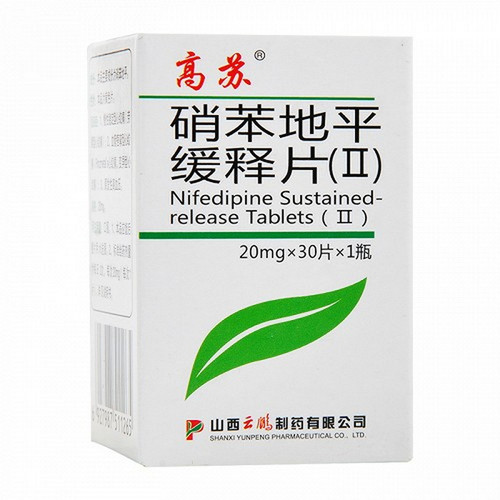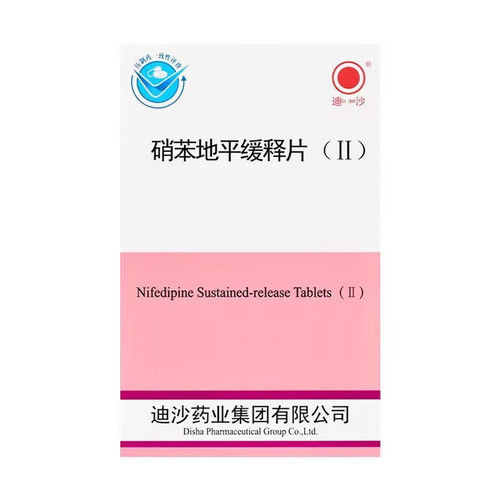Product Overview
[Drug Name]
Generic Name: Nifedipine Sustained-Release Tablets (I)
Trade Name: Kaida Nifedipine Sustained-Release Tablets () 20mg*30s
Pinyin Full Code: KaiDaXiaoBenDiPingHuanShiPian(I) 20mg*30s
[Main Ingredients]
The main ingredient of this product is nifedipine.
[Properties]
Thin-coated tablets, appearing yellow after removing the film coating.
[Indications/Main Functions]
Chronic stable angina (exertional angina); vasospastic angina (Prinzmetal's angina, variant angina); essential hypertension.
Specifications]
20mg*30s
[Dosage and Administration]
1. Swallow the whole tablet on an empty stomach. Do not chew or break it into pieces. 2. Start with a small dose. The initial dose is 20 mg/time, and the maximum dose is 60 mg/time, once a day. The maximum daily dose does not exceed 120 mg. 3. The dose of nifedipine should be gradually adjusted according to the patient's tolerance and the control of angina pectoris. The patient's blood pressure should be monitored before increasing the dose. If the patient's symptoms are obvious, the dose adjustment period can be shortened according to the patient's response to the drug. 4. No "rebound" symptoms were observed when the drug was discontinued, but the dose still needs to be gradually reduced, and the patient's condition must be closely observed. 5. The dose of ordinary preparations can be safely replaced with the dose of sustained-release preparations. For example: ordinary The general-release formulation is 30 mg three times daily, which can be replaced with a sustained-release formulation at 90 mg once daily.
[Adverse Reactions]
1. Common adverse reactions include peripheral edema (dose-proportional) and headache. 2. Adverse reactions with uncertain relationship to this product: dizziness; nausea; constipation; fatigue; facial flushing and hot sensation. 3.1% to -3% adverse reactions: chest pain; leg pain; paresthesia; vertigo; rash; leg cramps; epistaxis; rhinitis; impotence; frequent urination. 4. <1% adverse reactions: cellulitis; chills; facial edema; neck pain. Pelvic pain: atrial fibrillation, bradycardia/cardiac arrest; premature beats; hypotension, palpitations; phlebitis, induced hypotension, tachycardia; anxiety; hypotension, depression; insomnia, hypersomnia; pruritus; night sweats; abdominal pain; diarrhea; dry mouth; indigestion; esophagitis; bloating; gastrointestinal bleeding; vomiting, lymphadenopathy, gout, emaciation; arthralgia; arthritis; myalgia; dyspnea; cough; pharyngitis; blurred vision; amblyopia; conjunctivitis; diplopia; kidney stones, etc. 5. Rare adverse reactions: allergic hepatitis; alopecia; anemia; antinuclear antibody-positive arthritis; erythromelalgia; exfoliation; 6. Exfoliative dermatitis; fever; gingival hyperplasia; gynecomastia; leukopenia; mood swings; muscle pain; nervousness; purpura; tremor; sleep disturbances; Stevens-Johnson syndrome; syncope; thrombocytopenia; toxic epidermal fusion necrosis; transient blindness at peak blood concentration; tremor; urticaria, etc.
[Contraindications]
Contraindicated in patients allergic to nifedipine.
[Drug Interactions]
1. Used in combination with nitrates to control angina attacks, this product is well tolerated. 2. Used in combination with β-receptor blockers, this product is well tolerated and effective in most patients, but may induce and aggravate hypotension, heart failure, and angina in some patients. 3. Used in combination with digitalis, this product may increase blood digoxin concentrations. Therefore, digoxin blood concentrations should be monitored during initial use, dose adjustments, or discontinuation of this product. 4. Protein binding. 5. When used with cimetidine, the peak plasma concentration of this drug increases; therefore, adjust the dose accordingly. 6. When grapefruit juice is taken with this drug, the Cmax and AUC of this drug increase.
[Precautions]
1. Hypotension: Most patients experience only mild hypotension after taking nifedipine. Some patients experience severe hypotension, which often occurs during the dose adjustment period. Or increase the dose, especially when used in combination with? -receptor blockers. Blood pressure needs to be monitored during this period, especially when used in combination with other antihypertensive drugs. 2 Peripheral edema: The patient's mild to moderate peripheral edema is proportional to the dose taken and is related to arterial dilation. Edema often occurs initially at the end of the lower limbs and can be treated with diuretics. For patients with congestive heart failure, it is necessary to distinguish whether the edema is caused by further deterioration of left ventricular function. 3. Interference with diagnosis: When using this product, alkaline phosphatase, creatine phosphokinase, lactate dehydrogenase, and aspartate are occasionally seen. Elevated aminotransferase and alanine aminotransferase levels are generally asymptomatic, but cholestasis and jaundice have been reported; platelet aggregation is decreased, bleeding time is prolonged; and direct Coomb's test is positive with or without hemolytic anemia. 4. Patients with hepatic and renal insufficiency or those taking β-receptor blockers should use this drug with caution. It is advisable to start with a low dose to prevent inducing or aggravating hypotension and increasing the incidence of angina pectoris, heart failure, and even myocardial infarction. Patients with chronic renal failure may occasionally experience reversible increases in blood urea nitrogen and myosin. The relationship with nifedipine is unclear.
[Pediatric Use]
Contraindicated in children.
[Elderly Use]
This drug has a prolonged half-life, increased Cmax and AUC, and should be started at the lowest dose to reduce the incidence of adverse reactions.
[Overdose]
Insufficient research data are available. Existing literature suggests that increasing the dose can cause excessive peripheral vasodilation, leading to or exacerbating hypotension. Patients with clinical hypotension due to drug overdose should receive prompt cardiovascular support, including cardiopulmonary monitoring, lower limb elevation, and monitoring of circulating blood volume and urine output. Vasoconstrictors (norepinephrine) can be used to restore vascular tone and blood pressure, unless contraindicated. Drug clearance is prolonged in patients with impaired liver function. Hemodialysis cannot eliminate nifedipine.
[Pharmacology and Toxicology]
Nifedipine is a dihydropyridine calcium antagonist that selectively inhibits transmembrane transport of calcium ions into cardiomyocytes and smooth muscle cells and inhibits calcium ion release from intracellular stores without altering plasma calcium concentration. Pharmacological Actions This product can simultaneously relax the coronary arteries in the normal blood supply area and the ischemic area, antagonize spontaneous or ergonovine-induced coronary artery spasm, increase the delivery of myocardial oxygen to patients with coronary artery spasm, and relieve and prevent coronary artery spasm. It can also inhibit myocardial contraction, reduce myocardial metabolism, and reduce myocardial oxygen consumption. On the other hand, it can relax peripheral resistance vessels, reduce peripheral resistance, lower systolic and diastolic blood pressure, and reduce cardiac afterload. This product can delay the sinus node function and atrioventricular conduction of isolated hearts; electrophysiological studies on whole animals and humans have shown that this product can slow down the function of the sinoatrial node and atrioventricular conduction in isolated hearts. Studies have not shown that this product delays atrioventricular conduction, prolongs sinus node recovery time, or slows sinus node regeneration. Toxicological effects: Carcinogenicity, Mutagenicity, and Reproductive Toxicity: No carcinogenicity. It is non-mutagenic. High doses can reduce female mouse fertility; cause teratogenicity; and induce abortion (increased fetal drug absorption, increased fetal mortality, and decreased neonatal survival). Administration of 2/3 to 2 times the maximum human dose to pregnant monkeys resulted in small placentas and incomplete villous development; administration of 3 times the maximum human dose to rats resulted in prolonged pregnancy.







